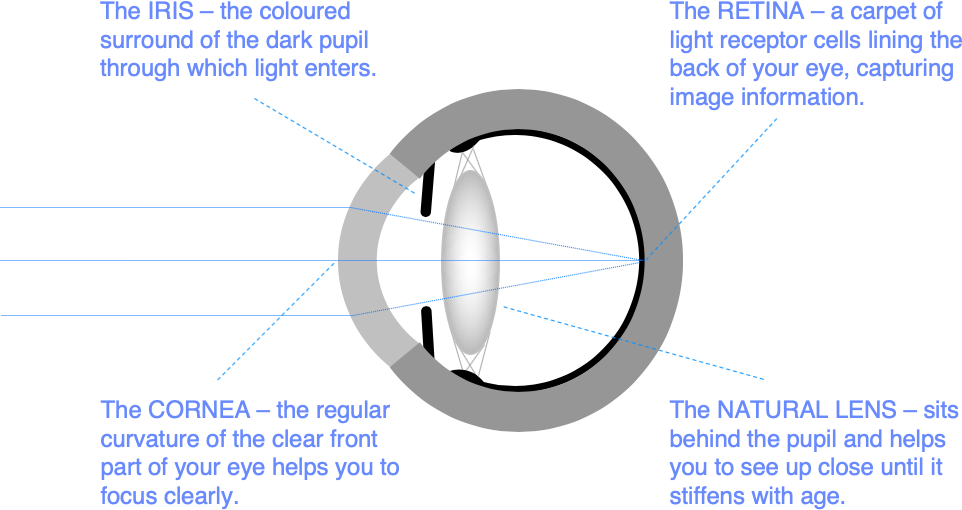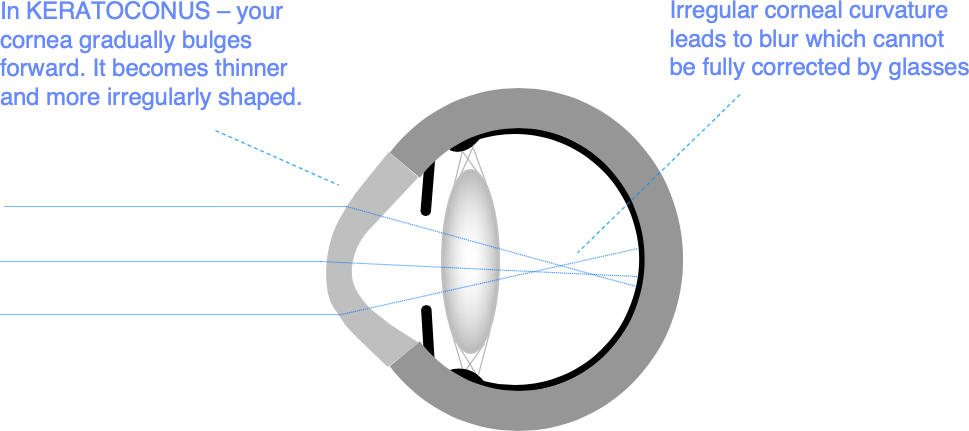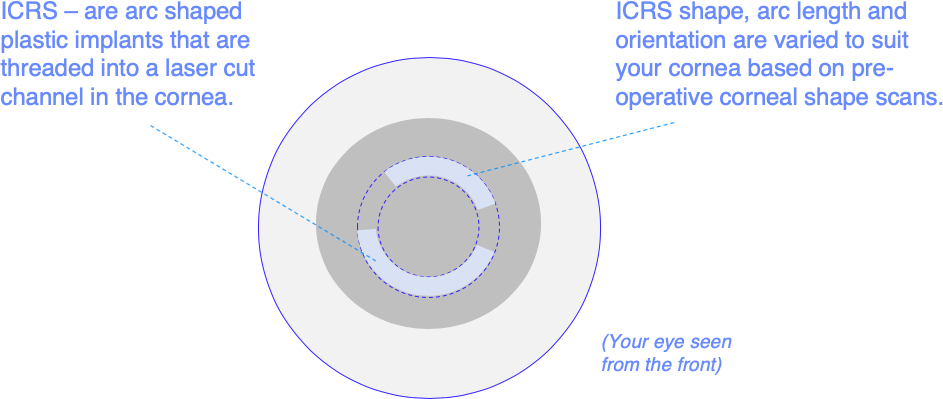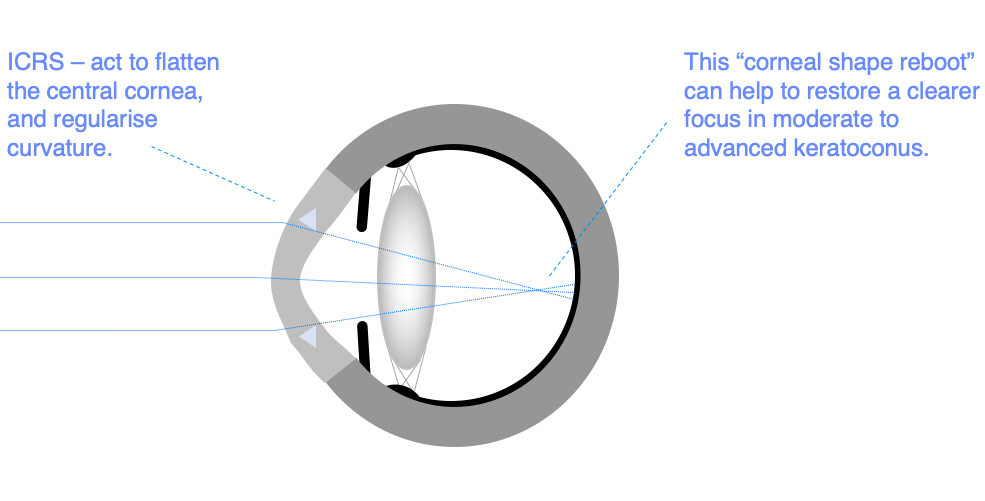You are here:
- Procedures / Keratoconus / ICRS
ICRS (Intracorneal Ring Segments) for Keratoconus
What is Keratoconus?
Keratoconus is a common cause of poor vision in young people caused by a progressive abnormality of corneal shape.
The cornea is the clear part of the front of the eye wall. You need a regular corneal curvature to help focus light accurately through the eye onto the retina.

In keratoconus, your cornea gradually bulges forwards, becomes thinner, and more irregular. It typically gets worse in the teenage years and through your 20s, before stabilising in your 30s. Although it is genetically determined, only about 10% of people with keratoconus have another affected family member, and one eye is often worse affected than the other.

What are intracorneal ring segments (ICRS)?
Intracorneal Ring Segments (ICRS) are small arc-shaped implants of varying thickness and length made of inert plastic which are implanted in a laser cut channel within the cornea. They act to provide a gross shape correction in moderate to advanced or keratoconus where vision is poor because of corneal shape irregularity.


ICRS implantation is a day case procedure performed under local anaesthetic, using drops to numb the eye. The procedure takes about 30 minutes and is painless, but some gritty discomfort is normal in the first 24 hours after surgery. We would recommend taking two days off work.
What are the benefits of ICRS?
ICRS act to flatten and regularlise the central cornea in keratoconus. The procedure is relatively low risk and recovery is quick, but the effects on vision are variable.
About 2 out of 3 people feel that they have had a worthwhile improvement in vision after treatment.
If you are offered ICRS as an initial treatment in keratoconus, this usually means that you are out of range for more accurate fine tuning of the corneal shape with laser treatment combined with corneal cross-linking (TransPRK/CXL) or customised corneal crosslinking (CuRV) which normally work best for earlier stage keratoconus. But successful ICRS can bring you back into range for these treatments, and vision can then be improved still further with ICL implantation.
ICRS implantation may save the need for corneal transplantation. ICRS can be removed if there are problems, and they do not stop you having successful corneal transplantation if this proves to be necessary.
Does ICRS implantation stabilise corneal shape in keratoconus?
We do not know if ICRS implantation helps to stabilise corneal shape without corneal crosslinking (CXL). The current consensus is that CXL to lock in the improved corneal shape is beneficial as a follow-on procedure for most younger patients after ICRS. This can be combined with TransPRK if necessary. Follow-on surgery is normally performed 3-6 months after ICRS implantation. If you are in your mid-30s or older, follow-on CXL may not be necessary, and we may simply continue with annual corneal shape monitoring visits for 3 years to check stability.
Who is suitable for ICRS?
ICRS implantation is generally offered to patients with moderate to advanced keratoconus who would otherwise need a corneal transplant to restore good vision.
At an earlier stage, combined laser treatment and crosslinking (TransPRK/CXL) is often a better choice, but if your vision in glasses is already worse than the driving standard at your initial keratoconus consultation, we are likely to recommend ICRS as your best treatment option.
What are the alternatives?
Specialised contact lens wear
If you are comfortable and seeing well in specialised contact lenses, crosslinking to stabilise the corneal shape in order to keep a good contact lens fit may be the best treatment option.
Corneal transplantation
In advanced keratoconus, corneal transplantation in which the abnormally shaped central cornea is replaced with a normal donor cornea is the best option. Corneal transplantation can be repeated if necessary, and fine-tuning revision surgical procedures can be used to optimise vision after healing. 4 out of 5 patients are able to see at the driving standard in glasses again within a year of corneal transplantation for keratoconus, and the transplant stays clear for at least 5 years in 19 out of 20 patients.
How is ICRS implantation performed?
ICRS implantation is an outpatient treatment that takes about 20 minutes. You are lying down for the treatment, which is performed using local anaesthetic eye drops. The upper part of your face is covered in a clear plastic sterile drape to help preserve sterility during the implantation stage, your eyelashes are taped out of the way, and a small spring clip helps to keep your eyelids open during treatment.
If you need treatment in both eyes, we can normally treat both eyes sequentially in the same session.
Essential steps in ICRS implantation are:
- Femtosecond laser application – we apply a small suction cup to the front of your eye to hold it steady with reference to a specialised laser which accurately cuts a small ring channel in your cornea about 6mm in diameter. You will feel some pressure on your eye as we dock the suction cup with the laser.
- ICRS implantation – we feed the ICRS into the laser cut channels beneath an operating microscope. You look up to a flashing green fixation light during this stage of the procedure. You can feel us touching around your eye, but no pain.
What are the risks?
Problems with vision
The main risk of ICRS implantation is that you will not get a satisfactory visual result. Approximately 1 in 3 patients feel that the procedure has not improved their vision.
Although some patients get a disappointing result, it is unusual for vision to be worse after ICRS implantation than it was before.
Additional surgery
ICRS removal or corneal transplantation may be required if ICRS implantation is unsuccessful.
ICRS removal is required in approximately 1 in 50 cases. Reasons for removal include failure to adapt to visual side effects, an inflammatory reaction, infection, or extrusion (ICRS implants coming back out of the implantation channel).
Infection or inflammation can result in permanent corneal scarring around the ring channel. But this block of tissue is removed completely if corneal transplantation is necessary. Paradoxically, this scarring can sometimes have a positive effect on corneal shape and vision. So corneal transplantation is not always necessary after ICRS removal.
We can sometimes improve vision after ICRS implantation with revision surgery to adjust the position of the implants within the ring channel.
ICRS removal or repositioning feels similar to the original implantation surgery, with a similar fast recovery.
ICRS implantation is often the best chance of improving your vision without a corneal transplant, but transplantation is the logical next step if you have problems after ICRS implantation or if you do not get a satisfactory visual outcome.
What are the side effects?
Side effects are problems which most patients experience to some degree after surgery. They normally improve with time, but do not always resolve completely.
Vision
It is normal to experience some light scatter side effects in the early period after ICRS implantation. Visual side effects can take a variety of forms including glare, halos, starbursts, floaters and ghost images. Increased flare from oncoming car headlights is a common symptom, and night driving may be difficult at first. Visual side effects usually improve within a few months as the visual areas of your brain adapt to the new visual input.
Eye comfort
Some eye surface discomfort is common in the early months after most forms of eye surgery. This is usually mild after ICRS implantation, and highly variable – often affecting one eye more than the other. Treatment and prevention are based on making sure your eye surface is healthy before and after surgery. Lubricant eye drops can be helpful, and can be taken safely in addition to your other medication when required. For patients with a normal eye surface prior to surgery, lasting problems are unusual.
Eye appearance
Red blotches are often visible on the white of the eye after any form of eye surgery. These are called subconjunctival haemorrhages, and are caused by a small leak of blood under the mucous membrane covering the white part of eye wall. Although they can be quite unsightly, red blotches are temporary, and do not affect eye health; but they can take up to 6 weeks to go away completely.
Will ICRS implantation affect my future eye care?
If you develop a new eye health problem in later life, ICRS should not prevent you having successful treatment. Common eye health problems like cataract, glaucoma, diabetic retinopathy, and age-related macular degeneration can be monitored and treated as normal after keratoconus treatments including CXL, ICRS, and corneal transplantation.
Once your corneal shape has been stable for 3 years after monitoring or CXL treatment, further keratoconus deterioration is less likely, particularly if you are able to avoid habitual eye rubbing. But changes can occur at any age. So, we would recommend continuing with an annual eye health check under the care of your local optometrist after discharge from regular review at Moorfields. Your optometrist will be able to pick up any new problems at an early stage.
Can I have treatment to reduce the need for glasses after ICRS?
The main aim of ICRS implantation is to restore a more regular corneal shape, but glasses or contact lenses are still normally required after treatment.
Once we are confident that your corneal shape is stable and has been optimised by follow-on TransPRK/CXL treatment, if required. You may wish to complete your visual rehabilitation journey with ICL implantation. This can be particularly helpful if you have a high spectacle prescription or if your spectacle prescription is much stronger in one eye than the other.
ICL implantation involves the implantation of a soft, corrective lens just behind the iris. It is a safe option for keratoconus patients, and is commonly used to correct high levels of short sight and astigmatism.
How can I reduce the risk of problems?
You can eat and drink normally before treatment, and should take any regular medication as usual.
Stay as relaxed as you can during the procedure, and try to keep your head still after we have positioned it comfortably for you. Look up to the green flashing target light above your eye when we ask you to. This helps to keep your eye in the best position for treatment.
Most people are anxious prior to treatment. We are used to this, and we will talk you through the procedure, encouraging you at every stage. Keep your breathing calm and tell us if you need a break. An anti-anxiety, muscle-relaxing drug such as diazepam can be helpful, particularly if you tend to squeeze your eyes shut when they are being touched. Let us know if you are worried, and we will help you to relax.
A spring clip is used to hold the eyelids apart during treatment, and we gently hold your eyes still when we need to. So, you should not worry too much about moving or blinking during the procedure. But try to listen to instructions and keep your eyes on the flashing fixation light when asked to do so.
You can wash and shower normally from the day after surgery. Sports can be resumed as soon as you feel comfortable again.
Set a smart phone reminder and use the antibiotic and anti-inflammatory drops as prescribed to help the eyes to heal well. It is good to leave at least 2 minutes between different types of eye drop so that they each absorb well before the next drop is applied. If you miss the first time or you are not sure, applying a second eye drop is no problem.
Some variability of vision and comfort is normal in the early weeks after surgery, and patience is required. But you should not be afraid to contact us if you have any concerns, or if you have an injury to the eye. You should contact us without delay if you have increasing pain, light sensitivity, redness, blur or an injury to the eye followed by pain, blur or watering. You will be given Mr Allan’s mobile phone number for emergency contact after surgery. The practice management and the laser nursing team are also available for informal advice. The Eye Casualty Department at Moorfields Eye Hospital is open for emergency review 24 hours a day, 7 days a week.
You may not be aware of a problem that requires treatment in the healing phase. So, make sure you attend your review appointments even if your eyes feel good.
Appointments and enquiries
To arrange a private consultation, please telephone Angelique Thomas on 020 7566 2156 or 07484 081815 (or from outside the UK +44 20 7566 2156 or +44 7484 081815) or email moorfields.ballan@nhs.net
For NHS treatment with Mr Allan’s team at Moorfields, you will need a referral from your GP or Ophthalmic Surgeon. Referrals should be addressed to Mr Bruce Allan, Consultant Ophthalmic Surgeon, Moorfields Eye Hospital, City Rd, London EC1V 2PD. If you have any difficulty with your NHS referral, please call Barbara Stacey, NHS secretary to Mr Allan on 020 7566 2320, or email barbarastacey@nhs.net.
